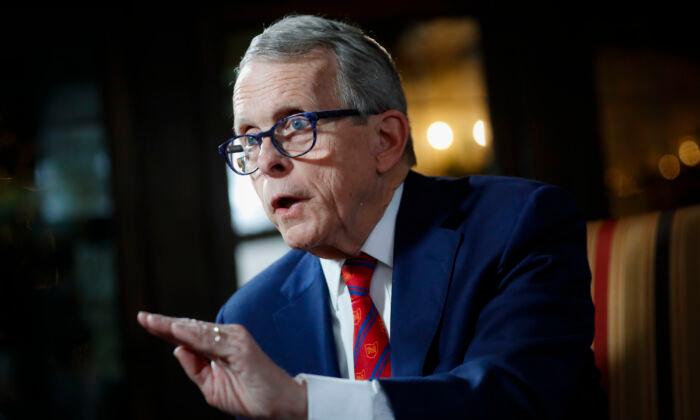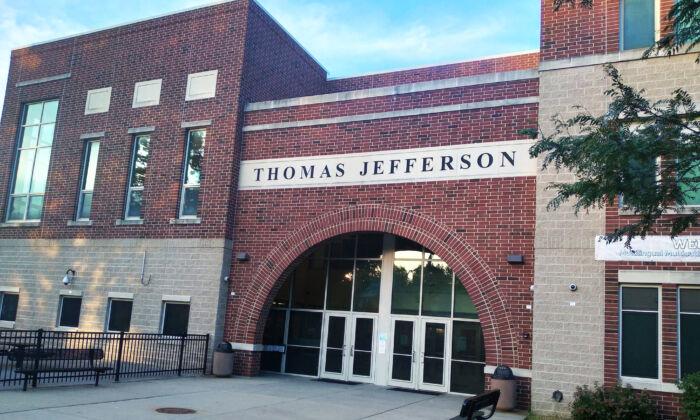As Major League Baseball ballparks host Opening Day events during the early days of April, America’s national pastime is set to embark on yet another year that begins with a crack of the bat, the pounding of a new leather glove, and a bit of change that’s all in the cards.
The 2022 season is marking the end of an era in Americana that stemmed from anticipation and excitement as the snow melted into spring, when fans would rush to corner stores and purchase cellophane packages filled with a pink slab of bubble gum and pictures of baseball heroes on cardboard rectangles.
Topps, which has since 1951 printed baseball cards featuring pictures of iconic players and one-season wonders on the front and their statistics and fun facts on the back, is retiring this year after a 71-year run.

In January, Fanatics—an e-commerce sports apparel giant based in Tampa, Florida—purchased the baseball card and collectibles arm of Topps for a reported $500 million.
The purchase came ahead of the end of Topps’s licensing agreement with Major League Baseball, which was set to expire in 2025.
This means Fanatics can immediately start designing and producing the cards, but the Topps brand—as fans and collectors know it—is stepping up to the plate one last time.
“With trading cards and collectibles being a significant pillar of our long-term plans to become the leading digital sports platform, we are excited to add a leading trading cards company to build out our business,” Fanatics CEO Michael Rubin said in a statement.
Those familiar with the company and collecting baseball cards have mixed emotions ranging from excitement, uncertainty, and anticipation of what Fanatics can bring to the hobby in the way of using technology and marketing in the digital age.
It remains to be seen whether Fanatics will replace the familiar Topps logo with its own, although Topps leaves a legacy that fans and collectors hope the new cardmaker will emulate.
“Topps is synonymous with baseball cards,” photographer Gregg Forwerck of North Carolina told The Epoch Times.
Forwerck was signing baseball players to the Topps contracts to appear on a card when it was announced the licensing agreement to produce cards was awarded to Fanatics.

Fans used to be able to purchase wax packs of the cards that included bubble gum for a nickel at the corner store, as Forwerck did as a kid growing up in Michigan hoping to find a card of Detroit Tigers superstar Al Kaline during the late 1960s and early ‘70s.
Their hope was in the fun and challenge of completing a set of 600-plus cards by the end of the season or at least getting their favorite player.
The cards were released in about five series throughout the year, which often made it harder to get the higher numbers in the set, as retailers phased out baseball cards to usher in the new football cards.
Forwerck just completed his 33rd spring training of taking pictures for Topps. He estimates more than 30,000 of his images have appeared on cards, including many special-issue sets with small pieces of a player’s game-used bat or uniform attached to them.
He and other photographers such as Ed Mailliard of Pennsylvania have taken the majority of the pictures from spring training in Arizona or Florida.
One of Mailliard’s favorite images that appeared on a baseball card is of Willie Stargell, the late Pittsburgh Pirates Hall of Fame slugger.
Mailliard said he happened to see Stargell after a spring training game in Florida in 1982, playing fungo with a group of kids. Stargell was still wearing his uniform, and Mailliard took some pictures of him. One of the photos was used on the last card Stargell appeared on—a 1982 Topps.

In the recent past, there had been talk about Topps including a microchip with the baseball cards that could allow collectors to watch a video of a star player playing in a game or possibly talking about their outlook on the upcoming season.
“I think fans want to be closer to the game,“ Forwerck said. ”It’s still popular to collect trading cards of your favorite player. I don’t think that’s going to go away. People get the cards hoping to get them signed. A lot of people keep them and pass them on.”
Forwerck is quick to note that he took many of the action shots of more modern-day superstars such as Hall of Fame pitcher Randy Johnson, and sluggers Barry Bonds, Mark McGwire, and Mike Trout, that have appeared on cards.
McWilliams, who took photos for Topps from 1971 to 1992, is proud to have taken the photo for the last card of then home run king Hank Aaron—taken in 1976 in Sun City, Arizona, where the Milwaukee Brewers trained.
He also took the picture of Hall of Famer-to-be Tony Gwynn during a spring training game in 1983 that appeared on his ‘83 Topps rookie card. Then a young San Diego Padres player, Gwynn is shown running up the base line after getting a hit in Yuma, Arizona, where the Padres trained at the time.
Collecting baseball cards didn’t begin as a kid’s hobby; nor is it just for kids today.
The earliest baseball cards are believed to be the ones produced by Old Judge Cigarettes in the late 1880s. The sport was taking hold and its fan base was growing. The cards were put in packs to garner more interest in the game.
But the rarest card is considered to be the 1909 T206 issue of Pittsburgh Pirates shortstop Honus Wagner that came in packs of Sweet Caporal cigarettes.

Although Wagner chewed tobacco, he didn’t want his likeness on the card to be associated with cigarettes as he believed it would encourage kids to smoke. He ordered the cigarette company to destroy his cards, but some had already made it into circulation.
Today, there are believed to be fewer than 30 of the T206 Wagner cards in existence.
In fact, one recently was on display at a sports memorabilia show the weekend of March 25–27 in Strongsville, Ohio. It was up for auction by Colorado-based Mile High Cards.
Although the condition of the card was professionally graded a “Low 1” on a scale of 1 to 10, it sold for $3.1 million, according to information from Mile High Cards.
The premier Topps baseball card remains the 1952 Mickey Mantle, his debut card for the company.
Other desirable cards in the hobby include 1909 T206 cigarette cards of Ty Cobb and Christy Mathewson; and 1933 Goudey cards of Babe Ruth and Lou Gehrig that fetch thousands of dollars.

Topps was founded as the Topps Chewing Gum Co, by brothers Abram, Ira, Philip, and Joseph Shorin in 1938, and in 1947, they introduced Bazooka Bubble Gum. But it wasn’t until 1951 that Topps started putting baseball cards in packages to help sell the gum, thanks to an idea from Topps executive Sy Berger.
Berger, who is considered “The Father of the Modern Day Baseball Card,” wanted to expand on putting more players on cards and make them bigger than the 1951 “inaugural set.” In 1952, Topps released a color set.
A ‘52 Topps Mantle card sold for $42,000 in an auction overseen by Colorado-based Mile High Card Co.

During the 1950s, the baseball card collecting world boomed and it seemed like cards came in every kind of product—Dan Dee Potato Chips, Red Man Tobacco, Red Heart Dogfood, Wilson Wieners, Kahn’s Wieners, and Hires Root Beer. The Bowman and Fleer gum companies got in on the game for a while, too.
The rest is baseball history.
In addition to Mantle cards remaining popular and expensive, vintage cards such as Willie Mays, Hank Aaron, Roberto Clemente, Ted Williams, Jackie Robinson, Stan Musial, and Pete Rose are also sought among collectors.
Topps was last owned by Tornante Co., which is run by former Disney CEO Michael Eisner, and private equity firm Madison Dearborn Partners.
Tornante and Madison Dearborn are holding on to Topps’s candy and gift card businesses and rebranding as the Bazooka Cos. after the company’s bubble gum with the famous mascot-like character Bazooka Joe.
Fanatics has aggressive aspirations to take over as the leader of the sports business world.
Last year, it secured trading card licenses for the National Football League Players Association and National Basketball Association. To land these agreements, Fanatics provided equity to leagues and player unions that is guaranteed to bring at least $1 billion in revenue over the duration of the partnerships.
As word continues to get out among collectors and fans that a new sheriff is in town, card shop owners said what Fanatics will bring to—or take away from—the hobby is a “wait and see” thing.
A pack of eight to 10 cards definitely no longer costs a nickel or 25 cents and hasn’t for a long time. In fact, a pack of Topps with 14 cards in it costs $4.99 if you can find them.
A packaged, sealed set of about 700 cards that Topps would provide to retailers and dealers costs $70 on average.
A 46-year-old father and his 15-year-old son who are avid collectors in the Dayton, Ohio, area are disappointed that Topps lost its licensing agreement with MLB and believe the hobby has turned more into an investment activity.

“I collected cards as a child, and now I and my son Colten have had some good times opening packs and sorting cards,” Sam Muhlenkamp told The Epoch Times.
“I thought it was a great way to spend time with him, and it turned into a great way to teach him some business lessons because the hobby seems to be all about profit these days—profit for the card companies who overproduce the cards and profit for all the flippers.”
Similar to Forwerck, Muhlenkamp has fond memories of buying packs of cards when he was about Colten’s age.
“I remember as a kid going up to the drugstore, buying a pack, collecting favorite players, and trading with friends daily,” Muhlenkamp said.
“Now, it seems really hard to find packs. The only place we have been able to find packs lately have been at local card shops like Maverick’s in Kettering [near Dayton].
“Maybe Fanatics can change that, but I really don’t see how. It is more of an investor problem, in my opinion.
“People are paying thousands of dollars for a card of a guy who has never played an MLB game yet, in hopes they are the next Mike Trout. Card collecting today is more like gambling.”
Streamlining, or finding what to like in the hobby as it has changed through the years, helps keep it enjoyable for Muhlenkamp and his son.
“As of now, Colten and I collect our favorite players, and I am trying to build mini-collections,” Muhlenkamp said.
Colten’s favorite player is Atlanta Braves’ second baseman Ozzie Albies; he has many of his cards.
Local sports card shops also are facing uncertainty because it’s too early to know what the availability of receiving vendor boxes or packs will be from Fanatics.
The release of the new cards in late winter and early spring remains a draw for customers to come into shops and see who they get in the packs.

Mike Siska, who owns Ideal Baseball Cards, an eclectic sports memorabilia shop in Cincinnati that sells rare vintage items as well as new cards, told The Epoch Times that a lot of things are still up in the air with how retailers and dealers will be affected. Siska’s father opened the shop 40 years ago, and he took it over in 1998.
“I would say within the next five years, there’s going to be a lot of changes coming to the hobby,” Siska said.
“We hope as dealers that we'll still be able to get packaged sets and boxes of packs that our customers can purchase at the start of or during a baseball season. They enjoy coming in here, looking around to see what they can find, and picking out a couple of packs of the new Topps cards.”
The first series of 2022 Topps baseball cards were released to retailers and dealers in February—a vendor’s box of 24 packs costs $110. Ideal Baseball Cards sold out of them in March. Topps Series 2 is expected to arrive at the shop in June, and Series 3, the final one of 2022, is expected to arrive in November, Siska said.
Doug Heflin, a research analyst who works in Siska’s shop, is affectionately referred to as a “baseball cardologist” because of his deep knowledge of the cards.
Heflin told The Epoch Times that the hot cards right now are of Boston Red Sox rookie Bobby Dalbec, Ryan Mountcastle of the Baltimore Orioles, and Juander Franco of the Tampa Bay Rays.

During the COVID-19 outbreak in 2020, the pandemic put sports collector shows and conventions on hold. However, online traffic for the hobby picked up, with more people turning to eBay to complete sets and purchase cards, Heflin said.
Although many current and former players sign autographs freely for fans and collectors, Fanatics is already moving in on the autograph market of Hall of Famers and the game’s current superstars.
Fanatics has also recently struck exclusive deals with Hall of Fame catcher Johnny Bench and MLB superstar Bryce Harper of the Philadelphia Phillies for autograph signings.
Before, former and current players usually went through an agent or signed contracts on their own when they did autograph signings.
Some collectors believe Fanatics could make it harder for some to purchase cards; others believe the company will expand the hobby by making their cards and products directly available through e-commerce or online orders.
“It‘ll be interesting to see what happens with baseball cards,” Forwerck said. “Fanatics has some ideas. I think they’ll go a little deeper with the hobby than Topps did.”




